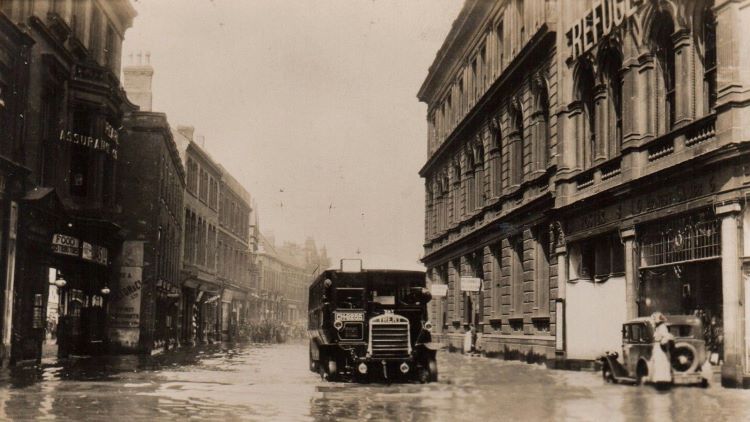The Great Flood of Derby – 1932.
Derby has, over the years, experienced many extreme weather events, indeed it has been recorded that substantial flooding was experienced in Derby on many occasions such as in 1673 and 1740 and also 1750 ,when it was reported that Derby had, “one of the most terrible tempests of lightning, thunder and rain that was ever known.” There was also the flood of 1842 which hit Derby so badly that a huge culvert had been built afterwards on Markeaton Brook, in an attempt to prevent a similar flood. However, in 1932 a flood overwhelmed those defences so dramatically that it became known as The Great Flood of Derby..

Although for a few days prior to Sunday May 22 of that year Derby had seen rather a lot of heavy rain there was, as described at the time, “no reason to anticipate the inundation that followed.” An inundation came however, and at speed, with “an avalanche of water such as human ingenuity was powerless to control.”
As the waters in Markeaton Brook entered the town of Derby it passed by St. John’s Church and moved along Brook Walk until it approached Ford Street. It was here that the culvert had been built ninety years previously in the hope of avoiding another large flood. Though it had so far served its purpose admirably on this occasion, “so great was the volume of water that it was now impossible to find a passage.” With the water unable to pass under the bridge it had nowhere else to go apart from pouring into the streets. Once this began the sheer speed of the flood was terrifying. It was said at the time that in “the low-lying parts of the town it gathered quickly, and by ten o’clock on this Sunday morning, shops in the Corn Market, St. James’s Street, and the bottom end of St. Peter’s Street were immersed halfway up the windows.” Flood markers had been placed on various places after the flood of 1842 to mark the height of that flood, and these were also covered making it Derby’s biggest ever flood. The centre of town was described as presenting “the appearance of a lake, and the sight was unforgettable.”
The electricity supply failed, as did the telephone service and the “town was soon in a plight that it had never imagined possible” as the “water swirled in the streets, twisting and tearing up road surfaces, broke plate-glass windows, poured into basements and ground floors of the shops and stores, and swept into banks and municipal offices, spreading damage everywhere.” The damage wasn’t restricted to the Sunday either, as damage cause by the flood that day caused an explosion the following day at H. Samuel’s in the Cornmarket. The shutters and windows were blown into the street with ten people requiring treatment at the Derbyshire Royal Infirmary, “whilst the police had a busy time collecting the watches and jewellery.”

The Wardwick in the aftermath of the flood.
Although the water receded almost as quickly as it had risen the trail of damage, both physical and financial, that it had left behind it didn’t. It was estimated that the damage done to property was to the value of around £400,000, around £21.5 million in today’s money. Tradespeople suffered heavily in terms of the value of individual losses, but it was the residents in the poorer districts who suffered the most and “in some cases had lost their all.” These were of course the people who were least likely to have any form of insurance. Those who lived close to the brook were of course hit very hard and it was described as a “scene of desolation in the congested areas bordering upon the course of the Markeaton Brook. Willow Row, Nuns Street, Brook Street and St. John’s Terrace were hit particularly hard with the inhabitants of Willow Row unable to leave their bedrooms.”
A relief fund was set up at the time by the Mayor – W.H. Salisbury – with the intent of raising a money for the worst victims. As part of that fund a “Souvenir of the Derby Floods”, booklet was released and available to purchase for 6d. It’s from that very booklet that the quoted information in this article is from in fact. Perhaps what also makes this flood all the more striking is that it was the first that was ever photographed, allowing us to gain a sense of perspective visually – though hopefully we will never have to take our smartphones out to record another one.


